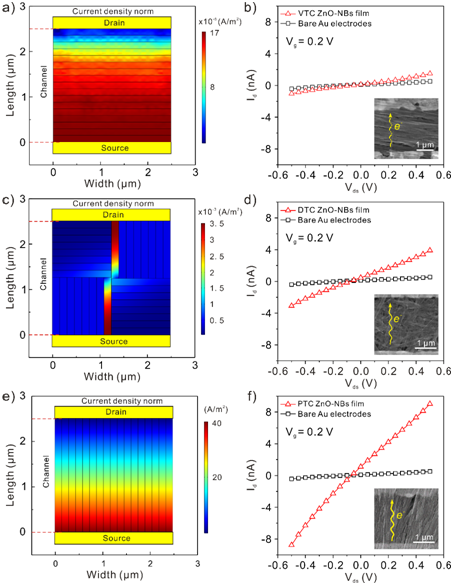The measurement of ultralow concentrations of heavy metal ions (HMIs) in blood is challenging and blood testing methods have been continuously improving. There is a strong tendency to develop the ultrasensitive chips with an ultralow minimum detectable level (MDL) for Hg2+ and easy operation at low price.
A research team led by Prof. HUANG Xingjiu from Institute of Intelligent Machines, Hefei Institutes of Physical Science, Chinese Academy of Sciences, recently developed a novel strategy with high sensitivity and stability to detect Hg2+ in the blood, which is very difficult to sense accurately in real samples of a drop of blood.
The work was published in the journal, Small. (https://onlinelibrary.wiley.com/journal/16136829)
Based on a typical two-dimensional (2D) semiconductor materials of ZnO nanobelts (Zn-NBs), the team combined Langmuir-Blodgett (L-B) technology and the method of thiol-functionalized molecular probe to design a solution-gated FET chip with oriented Zn-NBs array film. The as-prepared FET chips presented ultrasensitive performance when applied to sensing analytes due to the synergism of the field-induced effect and thiol group(-SH) specific binding of Hg2+ causing the electrical double layer (EDL) to change.
The present FET chip exhibits excellent response and selectivity toward Hg2+ as well as excellent repeatability and sensing capability in the determination of Hg2+ in a drop of blood.
Moreover, this work accurately analyzed the influence of the resistance of different assembly directions of ZnO-NB films on the current density by simulation. The results indicate that the nanodevices with the ZnO-NBs parallel to the channel (PTC) showed better responses than those with the ZnO-NBs disordered relative to the channel (DTC) or vertical to the channel (VTC).
This work was supported by the National Natural Science Foundation of China (Grant No. 61774159, 61474122, 21735005, and 61573334), the postdoctoral innovation talents supporting project (BX20180311), the China Postdoctoral Science Foundation (2019M652220), the Science and Technology Major Project of Anhui Province (17030801033), the CASHIPS Key Program of 13th five-year plan, the Science and Technology Research Project of Anhui Province (1704c0402195).
Figure 1. (a) The detection sketch map of the solution-gated FET device; (b)Real-time detection of Hg2+ at various concentrations in deionized water, the inset is a magnification of the low dropped concentration region (100 pM ~ 40 nM); (c) Selective responses of the FET chip to Hg2+ in the presence of other metal ions; (d)Optical photo of the oriented ZnO-NB array film FET chip and its SEM image of the sensitive area nanostructure.(Imaged by LI Yixiang)

Figure 2. Two-dimensional simulation graph of the normalized current density, and comparison of the electric performances under the three assembly conditions. a) Simulation graph and b) I-V plots of the VTC nanobelt film. c) Simulation graph and d) I-V plots of the DTC nanobelt film. e) Simulation graph and f) I-V plots of the PTC nanobelt film. All insets in the I-V plots correspond to SEM images of the three assembly conditions. The length of the device channel is 2.5 μm. The drain voltage is 0.5 V for all simulations.(Imaged by LI Yi-Xiang)
Title: Changing the Blood Test: Accurate Determination of Mercury(II) in One Microliter of Blood Using Oriented ZnO Nanobelt Array Film Solution-Gated Transistor Chips
Key words:2D material (nanobelt); assembled oriented film; solution-gated field-effect transistor (FET); sensing mechanism; blood mercury ion
Contact:
Prof. HUANG Xing-Jiu, Ph. D Principal Investigator
Institute of Intelligent Machines, Chinese Academy of Sciences
(http://www.iim.cas.cn)
Hefei 230031, China
Tel: 86-551-6559-1167
Email: xingjiuhuang@iim.ac.cn
